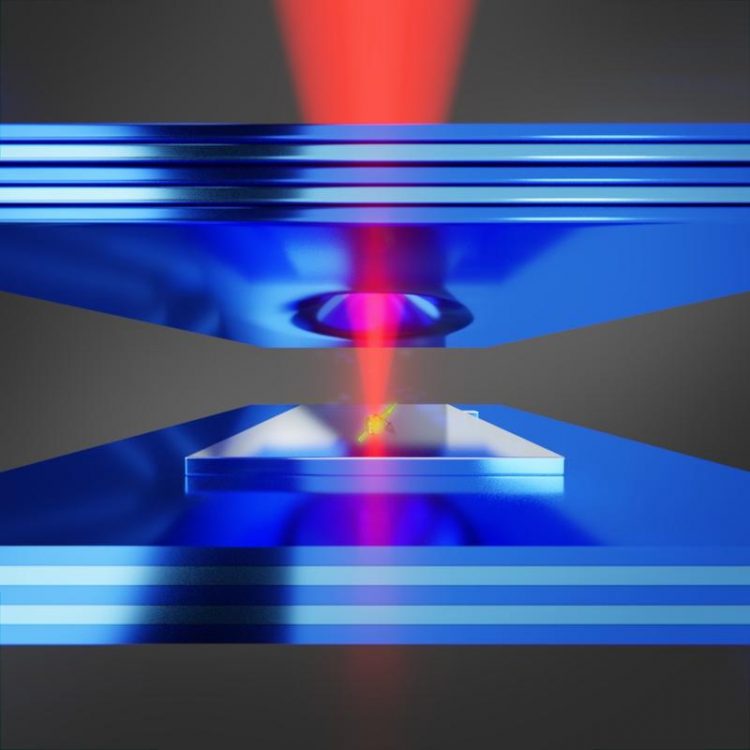Using Mirrors to Improve the Quality of Light Particles

A property of NV centers in diamond is that the states of their electron spins can be determined from the photons they emit. Image: University of Basel, Department of Physics
For a number of years, scientists have been working on using electron spins to store and process information. A possible approach is to use a quantum system in which the quantum state of the electron spin is linked to that of the emitted light particles (photons).
Nitrogen vacancy centers (NV centers) are considered a proven structure for this approach, allowing electron spins to be read and manipulated easily. These NV centers are natural defects in the crystal lattice of diamond, over which researchers have gained control over the last decades.
Better photons are needed
NV centers are particularly interesting in the field of quantum information processing, as they emit individual photons that carry information about the state of their electron spin. These photons in turn can create quantum entanglement between various NV centers; this entanglement can be established even over large distances and can thus be used for data transmission.
However, for applications in quantum information technology, significant improvements will be needed in the quantity and above all the quality of the emitted photons, since so far only a fraction of the photons can be used to produce entanglement.
Successful optimization
Doctoral student Daniel Riedel has now succeeded in boosting the yield of useful photons from these NV centers from 3% to a current value of 50%. In addition, he has been able to almost double the rate at which the photons are emitted.
Riedel achieved these significant improvements by placing a nanofabricated piece of diamond, measuring just a few hundred nanometers across, between two tiny mirrors. It had already been described theoretically 10 years ago that the placement of NV centers inside a cavity ought to increase the yield of photons. Until now, however, no research group had managed to put this theory into practice.
The paper emerged as part of a doctoral thesis at the Swiss Nanoscience Institute’s PhD School, which was established in 2012. “We have overcome an important hurdle on the path towards the quantum internet,” says supervisor Professor Richard Warburton of the Department of Physics at the University of Basel.
Professor Patrick Maletinsky, who also supervised the work, adds: “The unique combination of expertise in the field of photonics, special diamond structures and nanofabrication here in Basel meant it was possible to overcome this 10-year-old challenge for the first time.”
Original source
Daniel Riedel, Immo Söllner, Brendan J. Shields, Sebastian Starosielec, Patrick Appel, Elke Neu, Patrick Maletinsky, and Richard J. Warburton
Deterministic Enhancement of Coherent Photon Generation from a Nitrogen-Vacancy Center in Ultrapure Diamond
Physical Review X (2017), doi: 10.1103/PhysRevX.7.031040
Further information
Prof. Dr. Richard Warburton, University of Basel, Department of Physics, Tel. +41 61 207 35 60, email: richard.warburton@unibas.ch
Prof. Dr. Patrick Maletinsky, University of Basel, Department of Physics, Tel. +41 61 207 37 63, email: patrick.maletinsky@unibas.ch
https://www.unibas.ch/en/News-Events/News/Uni-Research/Using-Mirrors-to-Improve-…
Media Contact
All latest news from the category: Physics and Astronomy
This area deals with the fundamental laws and building blocks of nature and how they interact, the properties and the behavior of matter, and research into space and time and their structures.
innovations-report provides in-depth reports and articles on subjects such as astrophysics, laser technologies, nuclear, quantum, particle and solid-state physics, nanotechnologies, planetary research and findings (Mars, Venus) and developments related to the Hubble Telescope.
Newest articles

Properties of new materials for microchips
… can now be measured well. Reseachers of Delft University of Technology demonstrated measuring performance properties of ultrathin silicon membranes. Making ever smaller and more powerful chips requires new ultrathin…

Floating solar’s potential
… to support sustainable development by addressing climate, water, and energy goals holistically. A new study published this week in Nature Energy raises the potential for floating solar photovoltaics (FPV)…

Skyrmions move at record speeds
… a step towards the computing of the future. An international research team led by scientists from the CNRS1 has discovered that the magnetic nanobubbles2 known as skyrmions can be…





















